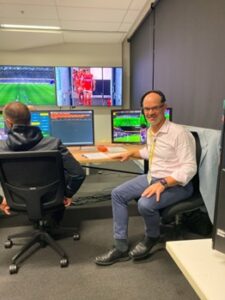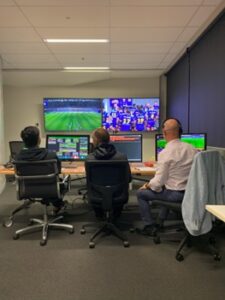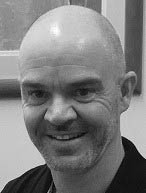Welcome to Orthosports Question for Physiotherapists June 2025. This month Dr Paul Annett discusses the NRL decision making behind the head injury process.
REMINDER: SAVE THE DATE Orthosports Annual Orthopaedic Updates, Saturday, 8th November, 2025, live @UNSW or via webinar. Registrations open later in the year.
If you have a Question that you would like answered on this monthly email please send to education@orthosports.com.au
QUESTION | I have been watching the NRL and am interested in the decision making process behind the head injury process. Could you explain it to me?
The NRL initiated the ISB (Injury Surveillance Bunker) just prior to the 2022 season. It was introduced to ensure the safe and accurate management of in game head injury, improving the immediacy of player removal from the field for head trauma and assisting the Club Medical Officer (CMO) in the management of game day concussion. One of the predictors of outcome and recovery is the rapid diagnosis of a concussion event, and a prompt removal of a player from the field as quickly as possible. Any delays in these steps gives less favourable outcomes.
I have been working in the ISB from its commencement, along with Dr John Best and Dr Leigh Golding, and a collection of other Sports Physicians and experienced sports doctors.
The purpose of the ISB is to use detailed video analysis to determine potential severity of an in-game head trauma or concussive force transmitted to the head. It is a system purely based on video signs noted and not a definitive diagnosis of concussion, which must be made with an accurate clinical assessment by the CMO. This is not to be confused with simply observing a heavy tackle or impact between players, which may look spectacular, but does not lead to clear video signs of concussion and mandate player removal from the field.
Logistically the ISB is located in a television studio in Redfern in Sydney, in conjunction with the video referee bunker. The ISB is made up of 5 people. There is a medical officer, 2 ‘spotters’ and 2 technical supports. The spotters are experienced and well-trained rugby league people (ex-players, physiotherapists, exercise physiologists). One spotter’s job is to watch the game continually and ‘tag’ any potential head impacts for more detailed analysis. These incidents will then be further scrutinized, with the second spotter and 1 of the technical supports providing the best of a series of multiple video angles (up to 12 camera angles), delivered to the medical officer, who ultimately decides whether the incident requires a classification or is deemed non-significant. In any one game of rugby league there may be numerous incidents of contact around the head, most of which do not require categorization. The second technician communicates with a sideline assistant at the ground, where there is video set-up for the CMO to review any incidents that occur. CMO review of the video footage is mandatory for any reportable incidents.
There are 2 main classification groups that the ISB works with – a Category 1 and a Category 2 concussion.
Category 1 signs indicate that the player has concussion and must be immediately removed from the field. They are not to be allowed to return to play on that day, irrespective of symptom recovery during the game.
Category 1 signs include:
- Lying motionless (suspected loss of consciousness)
- Motor incoordination (ataxia or stumbling)
- Impact seizure
- Tonic posturing
- Lack of protective Action (Player becomes floppy)
- Blank or vacant look
Category 2 signs indicate the potential for concussion. When identified the player must be removed from the field and taken for a SCAT 6 assessment by the CMO. If the player passes this within an allocated 15minute time-frame, then they are free to return to the field of play.
Category 2 signs include:
- Lying motionless (>2, but <5 seconds) in the context of a head injury (possible LOC)
- Possible impact seizure
- Possible tonic posturing
- Possible motor incoordination
- Slow to stand (15 seconds)
In addition, if it is noted that the player doesn’t look right, looks dazed, shakes head, opens and closes eyes quickly, this may indicate category 2 symptoms.
A category 3 has also been devised which is designated as a ‘trainer check’. In these cases, there may have been a significant head impact although without clear category 1 or 2 signs. The ISB will ask the CMO to have the orange shirt trainer perform an on-field assessment of the player. If there are any concerns (such as failing orientation or Maddocks questions or any disturbance of balance) then the player can be upgraded to a category 2 by the trainer and removed for a SACT 6 assessment.
It has been determined that over the last 3 years the introduction of the ISB has led to a more rapid removal of players from the field. This is particularly for category 2 incidents where the player will be regularly removed in under 60 seconds. From a personal perspective the ISB has been a worthwhile initiative. I can recount numerous incidents, particularly in category 2 concussion, where both the head contact and subsequent signs were sufficiently obscured only to be noted on a single camera angle, which ultimately led to a player being removed from the field and subsequently failing the SCAT 6 assessment. As a result, there has been a clear improvement in the level of player safety with respect to immediate concussion management and potentially reducing the likelihood of developing long term issues such as CTE (chronic traumatic encephalopathy).




